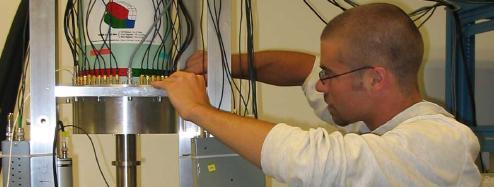
When ISAC-II comes on line in 2005, it will be supplying beam to, among others, the TRIUMF ISAC Gamma-Ray Escape-Suppressed Spectrometer (TIGRESS). Tigress will be a 2 m high pincushion of high-purity germanium (HPGe) detectors.
It will be able to produce high-resolution spectra of nuclear decays because of its ability to reduce the Doppler broadening of spectral lines. This will be possible because TIGRESS will know to within 1 mm where each gamma-ray interacts. This position sensitivity will be achieved in two ways: firstly, the HPGe crystals in the detectors will be electronically segmented to locate gamma interactions to within 25 mm; secondly, the output signals of the detector will be carefully analyzed and compared to calibration and stimulated signals from known locations. This pulse shape analysis has already been shown to give TIGRESS position sensitivities better than 1 mm. Knowing the geometry of the detector, the kinematics of the nuclear reactions and some relativistic mechanics, it will be possible to compensate for the Doppler shift of individual gamma-rays, almost eliminating the effect of the Doppler broadening.
TIGRESS spectra will also have a high signal to noise ratio because of the ability to ignore those gamma-rays which don't deposit all of their energy in the detector. High-density Compton suppressors will surround each detector in the TIGRESS array. When a gamma-ray escapes from the detector, it will be detected by the suppressors and its signals will be electronically vetoed.
